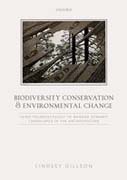
Biodiversity Conservation and Environmental Change: Using palaeoecology to manage dynamic landscapes in the Anthropocene
Gillson, Lindsey
Illustrates how a knowledge of long-term change in ecosystems can inform and influence their conservation, integrating perspectives from archaeology, environmental history and palaeoecology Describes the implications of long-term ecology for biodiversity conservation and ecosystem management, providing a context for interpreting today's changing landscapes Includes topical case studies with a broad geographical and taxonomic coverage to ensure the book's global relevance Ecosystems today are dynamic and complex, leaving conservationists faced with the paradox of conserving moving targets. New approaches to conservation are now required that aim to conserve ecological function and process, rather than attempt to protect static snapshots of biodiversity. To do this effectively, long-term information on ecosystem variability and resilience is needed. While there is a wealth of such information in palaeoecology, archaeology, and historical ecology, it remains an underused resource by conservation ecologists. In bringing together the disciplines of neo- and palaeoecology and integrating them with conservation biology, this novel text illustrates how an understanding of long-term change in ecosystems can in turn inform and influence their conservation and management in the Anthropocene. By looking at the history of traditional management, climate change, disturbance, and land-use, the book describes how a long-term perspective on landscape change can inform current and pressing conservation questions such as whether elephants should be culled, how best to manage fire, and whether ecosystems can or should be "re-wilded" Biodiversity Conservation and Environmental Change is suitable for senior undergraduate and post-graduate students in conservation ecology, palaeoecology, biodiversity conservation, landscape ecology, environmental change and natural resource management. It will also be of relevance and use to a global market of conservation practitioners, researchers, educators and policy-makers.
- ISBN: 978-0-19-871304-3
- Editorial: OXFORD UNIVERSITY PRESS.
- Encuadernacion: Rústica
- Páginas: 240
- Fecha Publicación: 09/04/2015
- Nº Volúmenes: 1
- Idioma:
